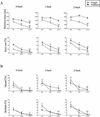Audiospatial and visuospatial working memory in 6-13 year old school children
- PMID: 12551966
- PMCID: PMC196650
- DOI: 10.1101/lm.53503
Audiospatial and visuospatial working memory in 6-13 year old school children
Abstract
The neural processes subserving working memory, and brain structures underlying this system, continue to develop during childhood. We investigated the effects of age and gender on audiospatial and visuospatial working memory in a nonclinical sample of school-aged children using n-back tasks. The results showed that auditory and visual working memory performance improves with age, suggesting functional maturation of underlying cognitive processes and brain areas. The gender differences found in the performance of working memory tasks suggest a larger degree of immaturity in boys than girls at the age period of 6-10 yr. The differences observed between the mastering of auditory and visual working memory tasks may indicate that visual working memory reaches functional maturity earlier than the corresponding auditory system.
Figures




Similar articles
-
Working memory, psychiatric symptoms, and academic performance at school.Neurobiol Learn Mem. 2005 Jan;83(1):33-42. doi: 10.1016/j.nlm.2004.06.010. Neurobiol Learn Mem. 2005. PMID: 15607686 Clinical Trial.
-
Modulation of slow brain potentials by working memory load in spatial and nonspatial auditory tasks.Neuropsychologia. 2000;38(7):913-22. doi: 10.1016/s0028-3932(00)00019-1. Neuropsychologia. 2000. PMID: 10775702 Clinical Trial.
-
Working memory as separable subsystems: a study with Portuguese primary school children.Span J Psychol. 2013;16:E14. doi: 10.1017/sjp.2013.6. Span J Psychol. 2013. PMID: 23866207
-
Development of a superior frontal-intraparietal network for visuo-spatial working memory.Neuropsychologia. 2006;44(11):2171-7. doi: 10.1016/j.neuropsychologia.2005.11.019. Epub 2006 Jan 6. Neuropsychologia. 2006. PMID: 16405923 Review.
-
Neural circuits in auditory and audiovisual memory.Brain Res. 2016 Jun 1;1640(Pt B):278-88. doi: 10.1016/j.brainres.2015.11.042. Epub 2015 Dec 2. Brain Res. 2016. PMID: 26656069 Free PMC article. Review.
Cited by
-
Functional connectivity of intrinsic cognitive networks during resting state and task performance in preadolescent children.PLoS One. 2018 Oct 17;13(10):e0205690. doi: 10.1371/journal.pone.0205690. eCollection 2018. PLoS One. 2018. PMID: 30332489 Free PMC article.
-
Relationship between cognitive function and prevalence of decrease in intrinsic academic motivation in adolescents.Behav Brain Funct. 2011 Jan 14;7:4. doi: 10.1186/1744-9081-7-4. Behav Brain Funct. 2011. PMID: 21235802 Free PMC article.
-
The Development of Spatial Memory Analyzed by Means of Ecological Walking Task.Front Psychol. 2019 Mar 29;10:728. doi: 10.3389/fpsyg.2019.00728. eCollection 2019. Front Psychol. 2019. PMID: 30984092 Free PMC article.
-
Forward and Backward Masking of Consonants in School-Age Children and Adults.J Speech Lang Hear Res. 2018 Jul 13;61(7):1807-1814. doi: 10.1044/2018_JSLHR-H-17-0403. J Speech Lang Hear Res. 2018. PMID: 29971342 Free PMC article.
-
Effects of long term administration of testosterone and estradiol on spatial memory in rats.Res Pharm Sci. 2015 Sep-Oct;10(5):407-18. Res Pharm Sci. 2015. PMID: 26752989 Free PMC article.
References
-
- Achenbach TM. Burlington, VT: University of Vermont, Department of Psychiatry; 1991.
-
- Anourova I, Rämä P, Alho K, Koivusalo S, Kahnari J, Carlson S. Selective interference reveals dissociation between auditory memory for location and pitch. NeuroReport. 1999;10:3543–3547. - PubMed
-
- Baddeley AD. Oxford psychology series No. 11. Oxford, UK: Clarendon Press; 1986. Working memory.
-
- ————— Working memory. Science. 1992;255:556–559. - PubMed
Publication types
MeSH terms
LinkOut - more resources
Full Text Sources
